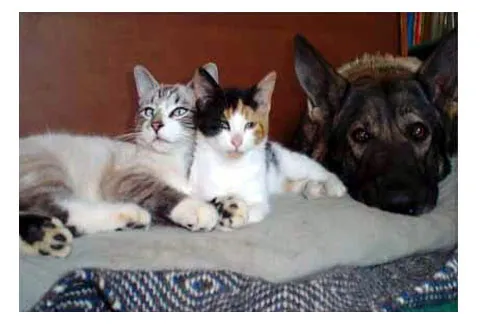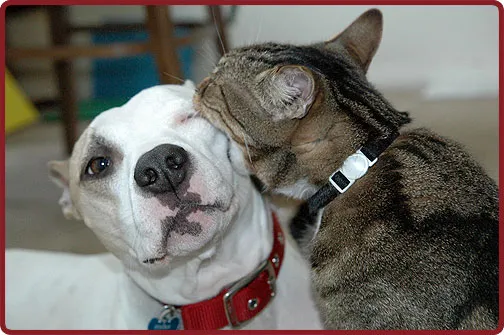Bringing a new dog or puppy into a home with existing cats often raises questions about how to ensure a peaceful coexistence. While it might seem like a daunting task, fostering a harmonious environment between canines and felines is achievable with the right approach and a clear understanding of canine behavior. Many dog owners are unaware of the profound genetic pack drive that dictates much of a domestic dog’s life. Cats, too, can sometimes initiate conflicts, making this a two-sided challenge.
Successful integration hinges on several key factors, including the new owners’ commitment to consistent training, their willingness to establish a clear pack structure, and their understanding of both dog and cat behaviors. It’s crucial to acknowledge that leaving animals to “sort things out” themselves is a recipe for disaster. Instead, a controlled, patient, and educated approach is essential. This guide will walk you through the steps to successfully introduce a dog into a household with cats, drawing on decades of experience in dog training and behavior. For more insights on cohabitation, consider exploring what makes dogs who can live with cats.
The Foundation: Controlled and Safe Exposure
The very first step in acclimating a dog to your feline companions is to provide strictly controlled and safe exposure. This means that the dog must be either in a dog crate or on a leash whenever they are inside the house for an extended period. This initial phase can last weeks, or even months, depending on the individual animals involved. There is no benefit to rushing this process; impatience often leads to behavioral issues and potential accidents. Owners who take their time establishing this new dynamic rarely encounter significant problems.
Using a dog crate is highly recommended as it offers the safest method for controlling the environment. It allows you to supervise the cats while the dog is safely contained within the same room. Initially, cats should be secured in a separate room before the new dog is even brought into the house. When the dog is first introduced to the main living areas, it should always be on a leash. This reinforces that entering the house is a controlled experience, preventing the dog from charging around and acting erratically. Maintaining control over both animals and their environment is paramount to avoiding incidents. If a cat runs and the dog attempts to chase, being on a leash provides immediate control.
 A dog calmly resting in a crate while a cat observes from a distance
A dog calmly resting in a crate while a cat observes from a distance
Many owners wonder when their dog can be allowed off-leash. The simple answer is: when you can consistently control your dog even when highly distracted. If your dog doesn’t reliably respond to commands like “come” when a cat is present, then off-leash freedom is premature. In such cases, the dog should remain leashed, crated, or, for more advanced training, consider using a remote collar. A practical test involves placing the cat in a dog crate before bringing the dog into the house on a leash. Drop the leash and let the dog drag it. If the dog loses control, you can quickly grab the leash and remove the dog from the situation.
Crate Training and Establishing Boundaries
Once the dog is in the crate in the presence of cats, the expectation is for them to remain calm and quiet. If the dog barks at the cats, a verbal correction is necessary. If barking persists, covering the crate with a sheet, using a mild deterrent like lemon water spray, or employing a bark collar (for dogs over 16 weeks old) can be effective. This consistent enforcement teaches the dog that reacting aggressively or excitedly towards the cats is unacceptable behavior.
During this initial phase, the dog is never allowed out of the crate while cats are in the room unless they are on a leash. This on-leash freedom is only granted after the dog has spent at least one week without barking at the cats from inside the crate. It’s important to clarify that this doesn’t mean dogs are confined to their crates for weeks on end. They can have supervised, on-leash free time in the house, but initially, cats should always be in a different, closed-off room during these periods.
When bringing an adult dog into the home, establishing pack structure is a top priority. It’s often advisable to wait several weeks before allowing any on-leash house time with cats present, focusing first on cementing the dog’s understanding of its place in the family hierarchy and the owner’s leadership role. Owners introducing dogs to cats are essentially managing two simultaneous processes: establishing pack structure with the new dog and teaching the dog that the cats are now part of their family pack, not prey. Patience and a methodical approach greatly minimize potential issues.
 A cat comfortably sleeping on a dog's bed, demonstrating peaceful coexistence
A cat comfortably sleeping on a dog's bed, demonstrating peaceful coexistence
During the time an adult dog spends in the crate, it can also be acclimated to wearing a muzzle. Wire basket muzzles are often preferred for their comfort and less restrictive nature, though plastic muzzles are a more affordable and effective alternative if fitted correctly. Introducing the muzzle during these initial weeks provides another focus for the dog, diverting their attention from the cats and making the muzzle a familiar, second-nature accessory. When the time comes to allow the dog to be loose in the room with the cats, even if on a leash, a muzzle can provide an added layer of safety.
Should an adult dog display any sign of aggression towards a cat, an immediate and appropriate correction is necessary. The intensity of this correction varies based on the dog’s temperament; some may only need a firm “NO,” while others might require a more significant correction, such as with a prong collar, to make the message clear. The correction must be strong enough to be memorable, discouraging future aggressive thoughts. A well-trained dog will view its owner as the pack leader, understanding that aggression is a prerogative of the leader, not lower-ranking members. If a dog repeatedly ignores warnings, it signals a need to revisit and reinforce pack structure and obedience training. This reinforcement will help the dog instinctively accept the owner’s leadership and the understanding that cats are not prey.
Advanced Training: The Remote Collar and Off-Leash Freedom
Eventually, the muzzle must come off. This transition should only occur when you are completely confident in your dog’s behavior around cats while on a leash. Patience is critical; for adult dogs and cats, this phase can extend for many months. Over time, they will gradually adjust to a shared lifestyle and territory.
For advanced proofing around cats, many experienced trainers advocate for the use of a remote collar. When used correctly with “low-level” stimulation, a remote collar can be a safe and efficient tool for teaching a dog that chasing cats is unacceptable. This method, when applied properly, can have a lasting impact on the dog’s behavior, reinforcing off-leash control and providing a means to curb unwanted behaviors like chasing. It provides a level of control and precision that other tools may not offer.
In this stage of training, if a dog still attempts to chase a cat, a “high-level” stimulation correction (distinct from the low-level used in general obedience) can be employed, likened to touching a hot stove. Often, a single, well-timed correction is sufficient. Afterward, even a glance at the cat can be met with a verbal “NO” and a low-level correction. The goal is to interrupt unwanted behavior before the dog reaches a high state of arousal, as a higher drive requires a stronger correction. Understanding canine dynamics is key, and sometimes, a story about a dog can illuminate these intricate behaviors.
Fostering Friendship and Preventing Incidents
The ideal scenario is for dogs and cats to become friends. However, there’s a delicate balance between allowing them to get to know each other and play, and maintaining a safe, controlled environment. Allowing running inside the house, even if it appears to be playful, should be avoided. A running cat can easily trigger a dog’s natural prey drive, leading to potentially tragic consequences. Tragedies have occurred when dogs, who lived peacefully with cats indoors, reacted with their prey drive when a cat ran outside, leading to fatal outcomes. This underscores the importance of erring on the side of caution and being vigilant about safety.
 A dog and cat sharing a moment of peace, signifying a successful integration
A dog and cat sharing a moment of peace, signifying a successful integration
Some cats adapt to dogs more readily than others. For instance, a kitten introduced to an older dog may form a strong bond, viewing the dog as a companion or even a “heating pad.” Over time, the dog might even allow the cat to share its food bowl, a remarkable feat for a dog that might otherwise be aggressive towards other canines. Conversely, some adult cats never fully “warm” to dogs, merely tolerating them individually and maintaining a certain distance, perhaps even hissing to assert boundaries. These cats often observe how dogs react to their more dog-friendly feline housemates to gauge their own responses.
Then there are the “cat tormentors” – felines who seem to instinctively know how to provoke a dog into a chase. An office cat might sit just outside a tethered dog’s reach, staring intently, and then suddenly jump and run, knowing it will drive the dog “nuts.” In such situations, the cat must also be corrected, either by chasing them away or using a water bottle. This demonstrates leadership to the dog, reinforcing that the owner controls the environment and approves or disapproves of actions, thereby further cementing the owner’s role as pack leader.
Introducing Puppies to Cats
Introducing a new puppy to an existing cat presents a unique set of considerations. With a young pup, the primary concern shifts to the cat’s claws, which can cause serious injury, including blindness, to an eight-week-old puppy in an instant. Therefore, safety measures are paramount for the puppy.
The same crate training steps apply here, helping the cat understand that the puppy is a new family member. For a puppy exhibiting strong prey drive, a puppy prong collar can be used, allowing the pup to drag a line in the house. If the puppy gets into trouble or tries to chase the cat, a correction should be administered. It typically takes only a few corrections for a puppy to learn that “NO” means “NO.” Crucially, after any correction, lavish the puppy with love and affection. The puppy must understand that you hold no grudges and remain its best friend. A good rule of thumb is to provide ten times the cuddling after any necessary correction.
 A small puppy interacting cautiously with a cat, learning boundaries
A small puppy interacting cautiously with a cat, learning boundaries
Conclusion
Achieving a peaceful cohabitation between your dog and cat requires patience, consistency, and a well-informed approach. It’s vital to remember to proceed slowly, allowing the animals to adjust at their own pace, which can often be a slow, gradual process spanning many months. The most crucial advice is to always err on the side of caution and never take unnecessary risks with your beloved pets’ lives. With dedication to controlled exposure, proper training, and firm but loving leadership, you can create a harmonious home where dogs and cats live together in peace.
